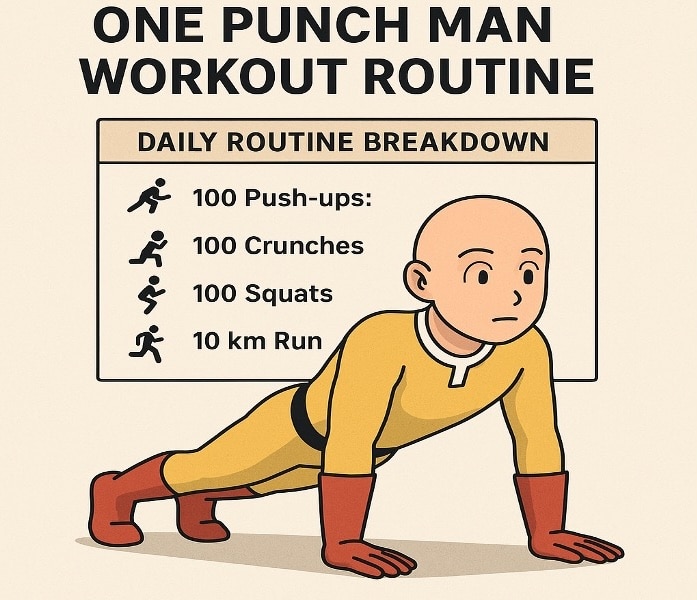One Punch Man Workout Routine: Is Saitama’s Workout Good?
The One Punch Man Workout Routine, inspired by the popular anime character Saitama, has captivated fitness enthusiasts and anime fans alike.
Saitama, the protagonist of the series, follows a simple yet rigorous workout regimen that transforms him from an ordinary man into the world’s strongest hero, capable of defeating any opponent with a single punch.
This workout routine has gained widespread attention for its straightforward approach and seemingly incredible results, but is the Saitama workout a good exercise routine?
As a professional athlete and life-long nerd, I think the One Punch Man workout is a good exercise routine you can do every once in a while, but it shouldn’t be your primary workout plan.
Read below to learn more about Saitama’s workout routine and how to use it as effectively as possible!
What is the One Punch Man Workout Routine?

Saitama’s path to becoming the world’s strongest hero began with no superpowers; just determination and discipline.
However, his simple yet grueling daily workout built both physical strength and unshakable mental toughness.
The One Punch Man Workout Routine focuses on consistency, endurance, and pushing past personal limits.
The One Punch Man workout routine consists of four fundamental exercises performed every day:
- 100 Push-ups: Strengthens the upper body, particularly the chest, shoulders, and triceps.
- 100 Crunches: Targets the abdominal muscles, enhancing core strength and stability.
- 100 Bodyweight Squats: Develops the lower body, including the quadriceps, hamstrings, and glutes.
- 10 km Run: Improves cardiovascular endurance and overall stamina.
Saitama completes this workout every single day without rest, no matter the conditions, which is a testament to his relentless dedication.
This unwavering routine forces the body and mind to adapt, building incredible endurance and resilience over time.
Ultimately, the One Punch Man Workout routine symbolizes the power of persistence, proving that extraordinary results come from ordinary exercises performed with extraordinary consistency.
Benefits of the One Punch Man Workout
The One Punch Man Workout Routine offers a surprising number of physical and mental benefits despite its simplicity.
While it doesn’t rely on complex gym equipment or advanced programming, it challenges every major muscle group and develops long-term discipline.
Builds Full-Body Strength and Endurance
The combination of push-ups, air squats, and crunches works nearly every major muscle group.
These bodyweight exercises build upper-body strength, improve leg power, and reinforce core stability, all of which are essential components of athletic performance.
Over time, this improves muscular endurance, allowing you to sustain higher workloads for longer periods.
Improves Cardiovascular Health and Stamina
The 10 km daily run plays a key role in increasing cardiovascular endurance and metabolic efficiency.
Consistent aerobic exercise training like this strengthens the heart, enhances lung capacity, and promotes better oxygen utilization throughout the body.
According to research, regular running also contributes to improved fat metabolism and healthier body composition (Kutac et al., 2023).
Supports Weight Management and Metabolic Health
Daily physical activity at this intensity boosts your basal metabolic rate (BMR), helping you burn more calories throughout the day.
The high repetition count promotes muscle activation and fat oxidation, supporting long-term weight maintenance.
Additionally, the combination of strength and cardio exercises improves insulin sensitivity and metabolic flexibility, both vital for sustainable fat loss.
Builds Mental Resilience and Discipline
Perhaps the most underrated benefit of the Saitama workout routine is its impact on mental toughness.
Training every day without excuses builds self-discipline, emotional endurance, and grit.
This consistency translates beyond fitness, improving focus, productivity, and stress management in everyday life.
Disadvantages of the Saitama Workout Routine
While the One Punch Man Workout Routine promotes consistency and endurance, it has notable limitations that should be considered. Its minimalist structure can be appealing for beginners but lacks essential elements for long-term, balanced progress.
Balancing the Saitama workout with rest days, resistance exercises, and mobility work can transform it from a basic challenge into a sustainable, effective training plan suitable for a wide range of fitness goals.
Limited Muscle Growth Potential
Because the Saitama workout relies solely on bodyweight exercises, it doesn’t provide enough progressive resistance to stimulate significant muscle hypertrophy.
Over time, the body adapts to fixed movements like push-ups and squats, which limit further strength and size gains.
To build more muscle, incorporating resistance training with weights or bands is far more effective.
Risk of Muscle Imbalances
The program heavily emphasizes pushing movements but completely omits pulling exercises.
Without pull-ups, rows, or posterior chain exercises, muscle imbalances can develop between the front and back of the body.
This not only affects posture but also increases the risk of overuse injuries.
A balanced routine should include exercises for both pushing and pulling muscle groups.
Overtraining and Recovery Issues
Performing the same high-intensity workout every single day, without rest, increases the risk of overtraining.
Rest days are essential for muscle repair, nervous system recovery, and performance gains.
Without proper recovery, fatigue accumulates, leading to burnout, decreased motivation, and a higher chance of injury.
Lack of Progression and Variety
The repetitive nature of Saitama’s routine means the body eventually stops adapting.
Progress plateaus when intensity and variation are not introduced over time.
To continue improving, athletes need to progressively overload their muscles, either by adding resistance, changing tempo, or varying exercise types.
Neglect of Joint Stability and Functional Strength
Since the routine omits exercises that challenge stabilizer muscles, it doesn’t adequately support joint health or athletic performance.
Functional movements that improve balance, coordination, and joint integrity, such as lunges, planks, or mobility exercises, are crucial for long-term injury prevention and overall performance.
Is the One Punch Man Workout Good?
The One Punch Man Workout Routine is good for building foundational strength, endurance, and mental resilience, but it’s not a complete fitness program or one of the best workout plans.
Its simplicity makes it appealing to beginners or those seeking a challenge inspired by anime, yet its lack of balance and progression limits long-term effectiveness.
For beginners, this routine can serve as an excellent entry point.
It teaches consistency, introduces essential bodyweight movements, and helps develop cardiovascular endurance.
The exercises (push-ups, crunches, squats, and running) cover major muscle groups while improving stamina and calorie burn.
For intermediate or advanced athletes, however, the routine falls short.
Without progressive overload, pulling exercises, or rest days, it can lead to overuse injuries and plateaus.
To continue making progress, more advanced lifters should integrate more resistance training, mobility work, and adequate recovery.
The real value of Saitama’s training lies in its philosophy of persistence, discipline, and daily effort.
These traits are what truly transform your body and mindset, no matter what training program you follow.
In short, the One Punch Man workout is good as a fitness challenge or short-term conditioning program, but it should be modified to suit your individual goals, recovery needs, and long-term health.
Final Thoughts: Should You Do the One Punch Man Workout Routine?

The One Punch Man Workout is a great way to stay healthy while enjoying an enjoyable workout routine.
It offers a unique and straightforward approach to fitness, emphasizing consistency, mental toughness, and basic bodyweight exercises.
While it effectively builds muscle endurance, cardiovascular health, and mental resilience, it has limitations in promoting significant muscle mass gains and balanced muscle development.
For beginners or those seeking a simple, disciplined routine, the Saitama workout can be a great starting point.
However, advanced athletes or individuals with specific fitness goals may need to supplement it with additional exercises, such as pulling movements and stability training, and incorporate rest days to prevent overtraining and ensure continuous progress.
Overall, the Saitama workout can be effective for improving general fitness and mental toughness, but it’s important to tailor it to individual needs and goals for optimal results.
This website does not provide medical advice. This website site does contain affiliate links, and purchases may earn a commission.
Read my Medical Disclaimer, Review Disclaimer, and Publishing Policies for more details. Use of this site indicates acceptance of these terms.



